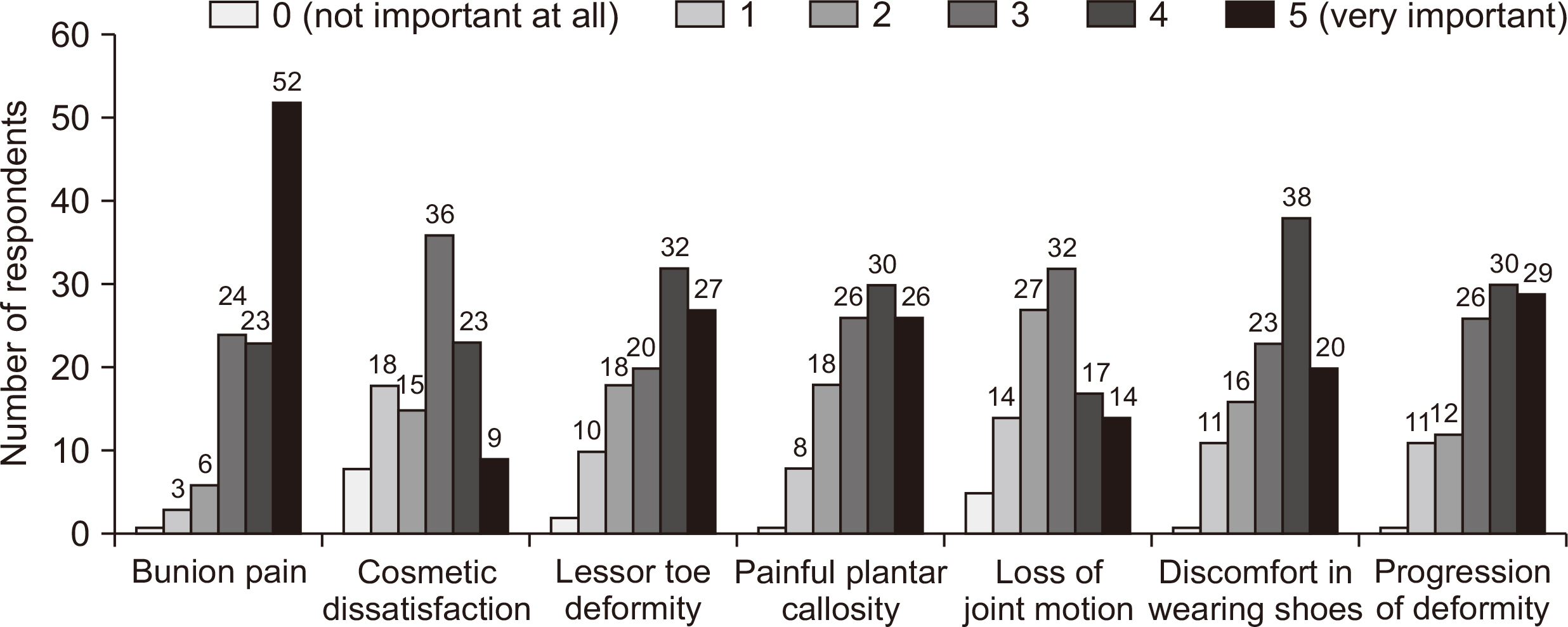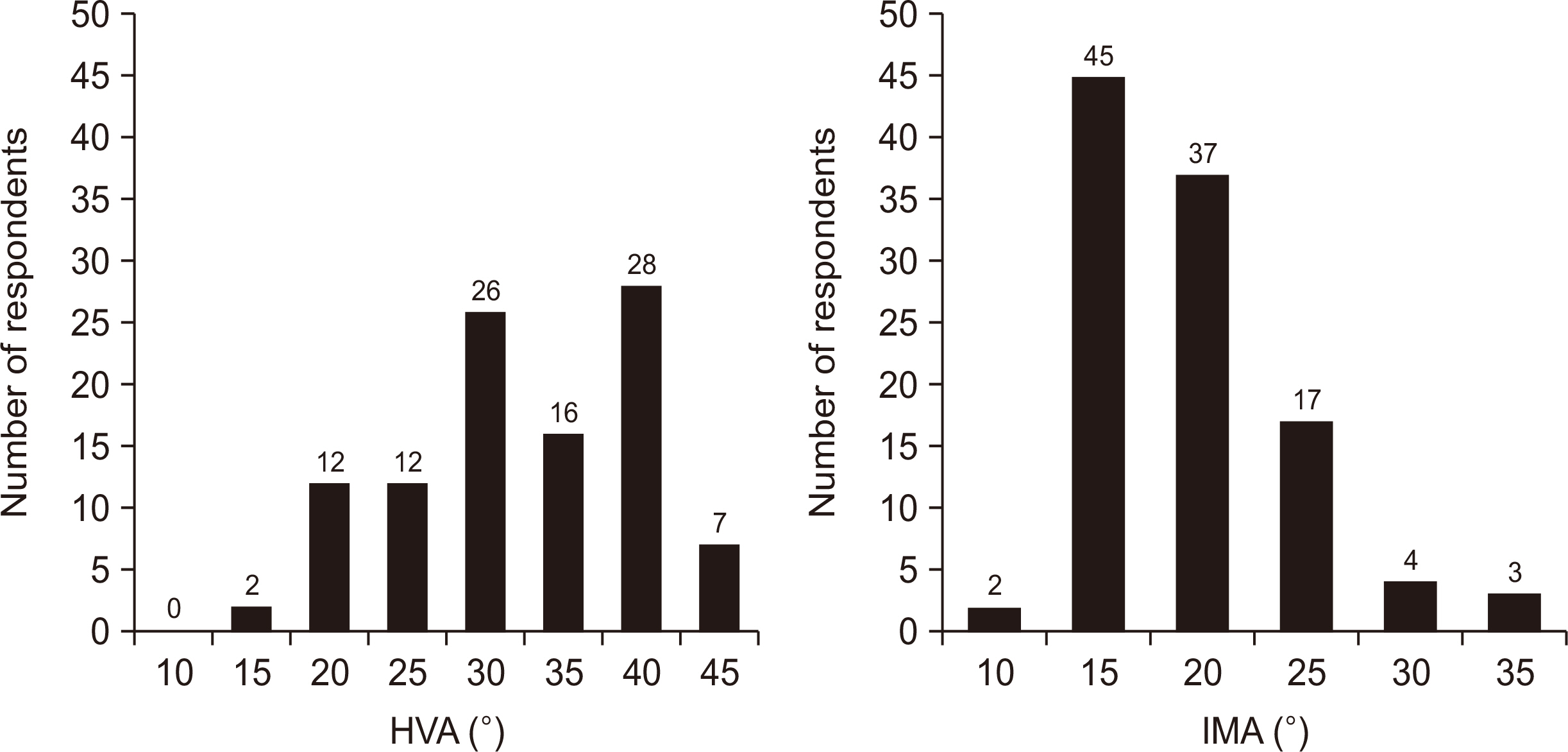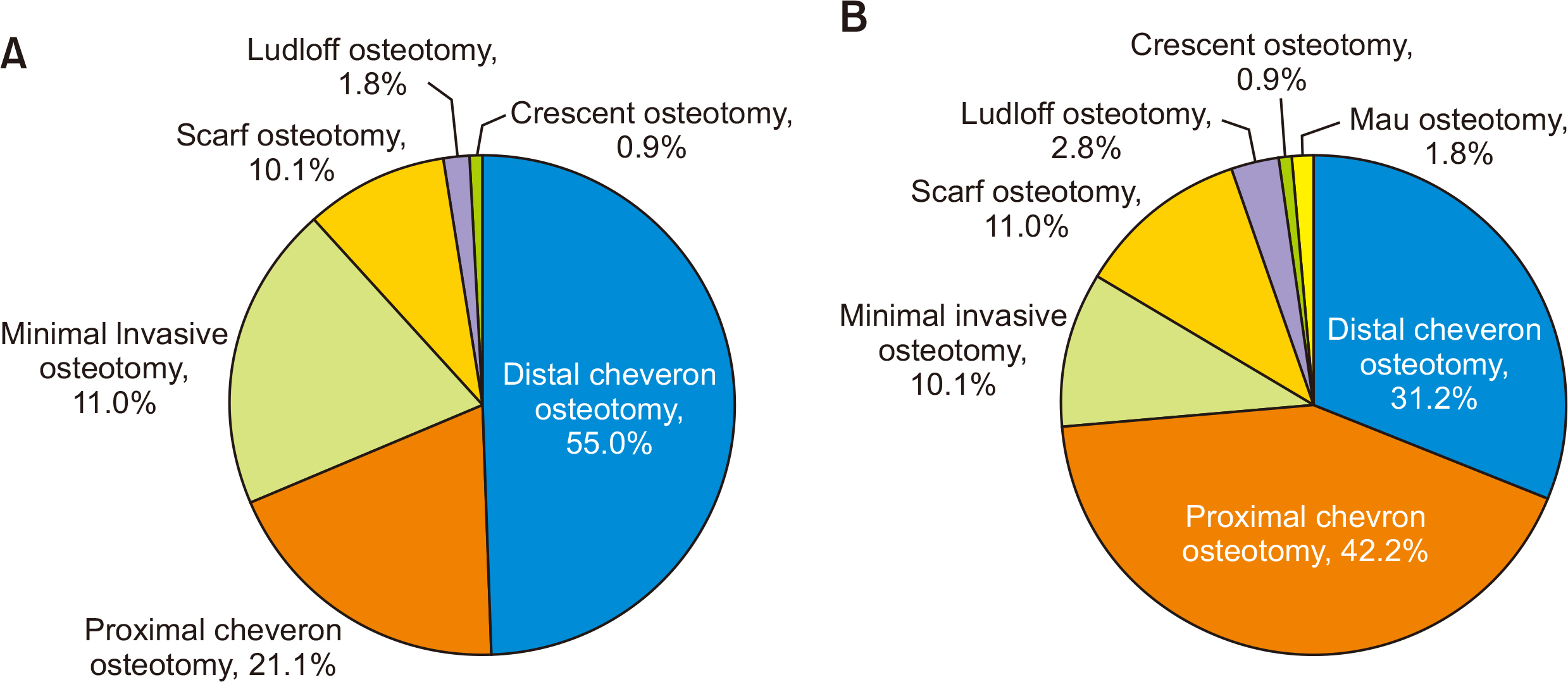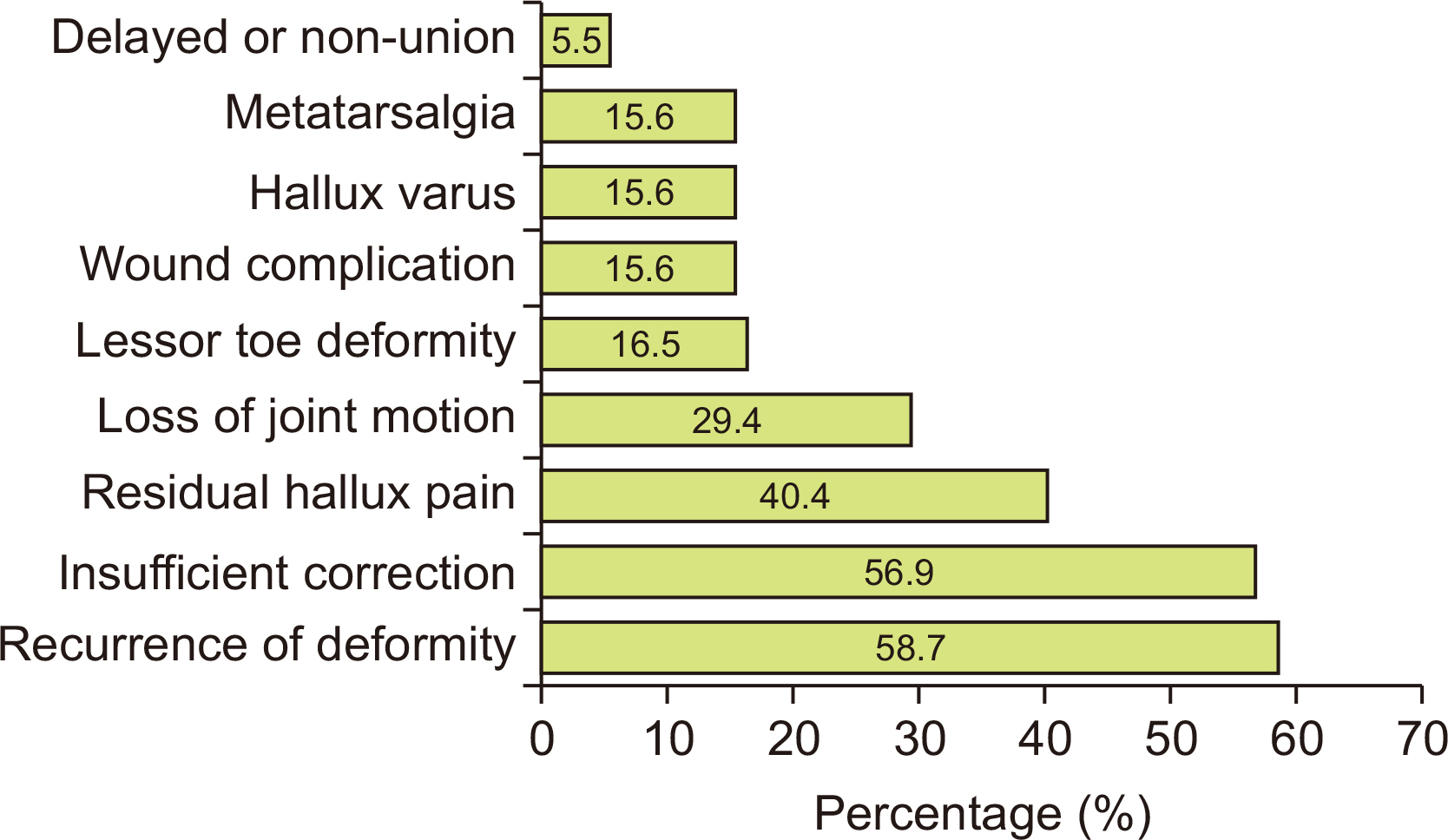J Korean Foot Ankle Soc.
2021 Dec;25(4):157-164. 10.14193/jkfas.2021.25.4.157.
Current Trends in the Treatment of Hallux Valgus: Analysis of the Korean Foot and Ankle Society (KFAS) Member Survey
- Affiliations
-
- 1Department of Orthopedic Surgery, Hallym University Chuncheon Sacred Heart Hospital, Chuncheon, Korea
- 2Department of Orthopedic Surgery, Chungbuk National University Hospital, Cheongju, Korea
- 3Department of Orthopedic Surgery, Dankook University Hospital, Cheonan, Korea
- 4Department of Orthopedic Surgery, Samsung Medical Center, Sungkyunkwan University School of Medicine, Seoul, Korea
- 5Department of Orthopedic Surgery, Inje University Sanggye Paik Hospital, Seoul, Korea
- KMID: 2523296
- DOI: http://doi.org/10.14193/jkfas.2021.25.4.157
Abstract
- Purpose
This study aimed to report the current trends in the management of the hallux valgus (HV) deformity over the last few decades through a survey of the Korean Foot and Ankle Society (KFAS) members.
Materials and Methods
A web-based questionnaire containing 34 questions was sent to all KFAS members in September 2021. The questions were mainly related to the preferred techniques and clinical experience in correction in patients with an HV deformity. Answers with a prevalence of ≥50% of respondents were considered a tendency.
Results
One hundred and nine (19.8%) of the 550 members responded to the survey. The most common symptom for determining surgical treatment was bunion pain (68.8%), and different surgical techniques were selected according to the following radiological parameters: HV angle 30 to 40 degrees and intermetatarsal angle 15 to 20 degrees. The two procedures most preferred by the respondents were distal chevron osteotomy (55.0%), and proximal chevron osteotomy (21.1%). In an average of 71.6% of respondents, Arkin osteotomy was performed simultaneously during HV surgery. HV accompanied by an overriding deformity of the second toe was most often addressed with a combination of second metatarsal osteotomy and soft tissue rebalancing procedure (35.8%). After HV surgery, the recurrence rate of HV deformity was found to be 12.2% on average and the surgeons who had performed minimally invasive surgery (MIS) for HV comprised 34.9% of the total respondents.
Conclusion
This study provides updated information on the current trends in the management of the HV deformity in Korea. Both consensus and variation in the approach to patients with HV were identified by this survey study. Although MIS for HV has increased, it appears the consensus for selecting this method has not yet been established.
Keyword
Figure
Reference
-
1. Coughlin MJ, Jones CP. 2007; Hallux valgus: demographics, etiology, and radiographic assessment. Foot Ankle Int. 28:759–77. doi: 10.3113/FAI.2007.0759. DOI: 10.3113/FAI.2007.0759. PMID: 17666168.
Article2. Nix S, Smith M, Vicenzino B. 2010; Prevalence of hallux valgus in the general population: a systematic review and meta-analysis. J Foot Ankle Res. 3:21. doi: 10.1186/1757-1146-3-21. DOI: 10.1186/1757-1146-3-21. PMID: 20868524. PMCID: PMC2955707.
Article3. Coughlin MJ, Thompson FM. 1995; The high price of high-fashion footwear. Instr Course Lect. 44:371–7. PMID: 7797875.4. Jang KS, Kim TW, Kim HJ. 2014; Diagnosis and pathophysiology of hallux valgus. J Korean Foot Ankle Soc. 18:43–7. doi: 10.14193/jkfas.2014.18.2.43. DOI: 10.14193/jkfas.2014.18.2.43.
Article5. Robinson AH, Limbers JP. 2005; Modern concepts in the treatment of hallux valgus. J Bone Joint Surg Br. 87:1038–45. doi: 10.1302/0301-620X.87B8.16467. DOI: 10.1302/0301-620X.87B8.16467. PMID: 16049235.
Article6. Coughlin MJ, Mann RA, Saltzman CL. 2006. Surgery of the foot and ankle. 8th ed. Mosby;Philadelphia:7. Hatch DJ, Santrock RD, Smith B, Dayton P, Weil L Jr. 2018; Triplane hallux abducto valgus classification. J Foot Ankle Surg. 57:972–81. doi: 10.1053/j.jfas.2018.02.008. DOI: 10.1053/j.jfas.2018.02.008. PMID: 29784530.
Article8. Foot and Ankle Working Committee; Chinese Association of Orthopaedic Surgeons Orthopaedic Branch; Chinese Association of Orthopaedic Surgeons. 2015; Consensus on surgical management of hallux valgus from China. Orthop Surg. 7:291–6. doi: 10.1111/os.12207. DOI: 10.1111/os.12207. PMID: 26819077. PMCID: PMC6584274.9. Iselin LD, Klammer G, Espinoza N, Symeonidis PD, Iselin D, Stavrou P. 2015; Surgical management of hallux valgus and hallux rigidus: an email survey among Swiss orthopaedic surgeons regarding their current practice. BMC Musculoskelet Disord. 16:292. doi: 10.1186/s12891-015-0751-7. DOI: 10.1186/s12891-015-0751-7. PMID: 26466998. PMCID: PMC4607006.
Article10. Noback PC, Trofa DP, Vosseller JT. Evidence versus practice: operative treatment preferences in hallux valgus. Foot Ankle Orthop. Published online December 12, 2018; doi: 10.1177/2473011418800239. DOI: 10.1177/2473011418800239.
Article11. Raikin SM, Miller AG, Daniel J. 2014; Recurrence of hallux valgus: a review. Foot Ankle Clin. 19:259–74. doi: 10.1016/j.fcl.2014.02.008. DOI: 10.1016/j.fcl.2014.02.008. PMID: 24878414.12. Kwon KB, Lee KM. 2019; Treatment of recurrent hallux valgus after surgery. J Korean Foot Ankle Soc. 23:149–53. doi: 10.14193/jkfas.2019.23.4.149. DOI: 10.14193/jkfas.2019.23.4.149.
Article
- Full Text Links
- Actions
-
Cited
- CITED
-
- Close
- Share
- Similar articles
-
- Current Trends in the Treatment of Diabetic Foot: Analysis of the Korean Foot and Ankle Society (KFAS) Member Survey
- Current Trends in the Treatment of Diabetic Foot: Analysis of the Korean Foot and Ankle Society (KFAS) Member Survey
- Technique Tip: A Simple Method to Treat Hallux Valgus with Severe Metatarsus Adductus
- Incidence of Hallux Valgus Interphalangeus in the Normal and Hallux Valgus Feet and its Correlations with Hallux Valgus Angle and Intermetatarsal Angle
- Treatment of Recurrent Hallux Valgus after Surgery








